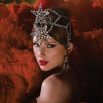Much like myself, french multi-instrumentalist Colleen aka Cécile Schott takes sonic influence from Terry Riley, Arthur Russell, traditional African and Jamaican music and, naturally, the Wu Tang Clan. All of which she delved into on her edition of VF Mix 14, a vinyl-only mix series hosted by The Vinyl Factory, quoting “Bells of War” as her choice Wu cut. These influences trace back to Cecille’s childhood obsession with her parents cassette tape “The Kings of Reggae”, mostly consisting of Lee “Scratch” Perry tracks from 1976 to 1979.
In her own work, she uses her voice and the baroque instrument treble viola da gamba to recite intricate tales of the human mind and heart. Her latest release, Captain of None on Thrill Jockey Records is possibly the most experimental album in her repertoire featuring tracks heavily influenced by her Jamaican and African music obsession, embossed bass lines and, new to her, percussive effects.
Recorded, mixed and produced entirely by Cecille in her San Sebastian, Spain music studio, Cecille imparted dub production techniques, a melodica, a Moogerfooger and delay pedal and echo effects. Another intricacy of Captain of None: rather than bowing the instrument in a traditional manner, Cecille tunes the viola da gamba like a guitar and plucks it for a fresh perspective on what a string instrument is and can be. I had an e-conversation with Colleen on her Thrill Jockey release, where her love of the viola da gamba came from and the very real struggle for non-American artists to tour in the States.
Classicalite: Captain of None, released in April on Thrill Jockey, features a traditional baroque instrument you play in futuristic tone. Why did you chose to work with the viola da gamba? How you know decide to pluck rather than bow the instrument?
Colleen: I have to start by specifying that I do not come from a classical or baroque background, because I think that has a lot to do with how I approach the instrument. I started playing the guitar as a Beatles-obsessed 15-year-old, but I heard and fell in love with the sound of the viola da gamba when I watched Alain Corneau’s French film Tous Les Matins du Monde on tv at the age of 16 or 17. The film did a lot to make the instrument and the music associated with it more well-known among non-specialist audiences in France. But, as far as I was concerned, playing the viola seemed like an unrealistic dream at best. My parents never had the finances at the time to acquire one. I lived in a small town where no viola de gamba teachers were to be found and I was incapable of reading a note on a score, which just seemed to prevent the whole thing from ever happening.
Many years later, once I had started my Colleen project and began to acquire more confidence as a self-taught player on several instruments, including the cello, I realized that nothing was keeping me from fulfilling my dream of playing the viola anymore. I ordered a bass viola da gamba from the excellent French luthier François Danger of Atelier des 7 cordes, and it was the start of a whole new journey. I did take about a year and a half of lessons in baroque music, which helped me grasp at least the basic spirit of that music, but I did not go further as I could feel that developing my own music on the instrument would be difficult if I kept pouring more energy in trying to learn the original viola repertoire.
© 2025 Classicalite.com All rights reserved. Do not reproduce without permission.




